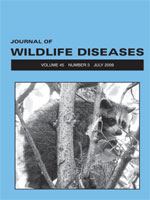Five cases of fatal babesiosis in free-ranging chamois (Rupicapra r. rupicapra) attributed to infections with Babesia capreoli were recently recorded in two regions of the Swiss Alps. To investigate the ecologic factors that possibly lead to those fatal B. capreoli infections in chamois, blood, ticks, and demographic data of 46 roe deer (Capreolus c. capreolus), 48 chamois, and nine red deer (Cervus elaphus) were collected in 2006 and 2007 in both affected regions. Whereas no parasitic inclusions were found by microscopical examination of blood smears, B. capreoli was identified by polymerase chain reaction/sequencing in blood of 12 roe deer (26%, 95% confidence interval [CI]: 14.3–41.1), one chamois (2%, CI: 0–6.1), and one red deer (11%, CI: 0.3–48.2). Prevalence of B. capreoli was significantly higher in roe deer compared with chamois (P<0.001). All 214 ticks were identified as Ixodes ricinus, and significantly more roe deer (63%, CI: 47.5–76.8) were infested compared with chamois (21%, CI: 10.5–35.0, P<0.001). Overall, prevalences of both tick infestation and Babesia infection increased significantly (P<0.001) with decreasing altitude, and Babesia-positive samples were detected significantly more often from animals with tick infestation compared with animals without ticks (P=0.040). Our results indicate that roe deer may play an important reservoir role for B. capreoli. It is hypothesized that the expansion of the presumed vector I. ricinus to higher elevations and its increased abundance in overlapping habitats of roe deer and chamois may favor the spillover of B. capreoli from roe deer to chamois.
How to translate text using browser tools
1 July 2009
BABESIA CAPREOLI INFECTIONS IN ALPINE CHAMOIS (RUPICAPRA R. RUPICAPRA), ROE DEER (CAPREOLUS C. CAPREOLUS) AND RED DEER (CERVUS ELAPHUS) FROM SWITZERLAND
Stefan Hoby,
Alexander Mathis,
Marcus G. Doherr,
Nadia Robert,
Marie-Pierre Ryser-Degiorgis

Journal of Wildlife Diseases
Vol. 45 • No. 3
July 2009
Vol. 45 • No. 3
July 2009
Babesia capreoli
babesiosis
chamois
elevation
epidemiology
red deer
roe deer




